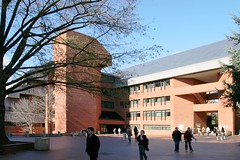A few last reflections on the southernmost continent.
I did indeed meet up with our colleagues Sarah Johnson and senior Angela Bai on my last day in Antarctica. They showed me their miniaturized sequencer that they plan to use to help unlock the mysteries of how microbes survive in the driest and coldest area of the world. There are other scientists interested in such questions because of the belief that the environment of Antarctica best resembles the environment of Mars, the next planet that humans aspire to visit. Doing science out in the field in Antarctica is not for those with casual interests. Helicoptering out to a site takes time; setting up a campsite is tricky. Winds are strong and sometimes prevent air travel back to the base station. Every bit of trash that humans produce must be packaged and later shipped back to the United States. There is no electricity in the field, and solar-powered devices are the norm.
So one tends to find unusually passionate researchers in Antarctica. Further, the mix of ongoing research permits new collaborations that wouldn’t normally form.
For example, one scientist interested in the geotectonic evolution of continental crust sat at breakfast with another never-before-met scientist who studies the climate of hundreds of thousands of years ago. The first was interested in drilling techniques that could relatively quickly get through thousands of feet of ice into the land, rock and soil below the ice. The second was interested in examining ice cores from drilling in multiple locations of interest at a much more rapid speed. (The typical ice core drill might spend 3 years working at one site.) Their new scientific drilling approach is designed to penetrate up to 3,300 meters of ice (nearly 11,000 ft.) and take sample cores in less than 200 hours. This rapid performance will allow a drilling crew to operate from start to finish in about 10 days before moving on to the next drilling site. In essence, more sites can be studied in much less time. A chance meeting at breakfast led to the collaboration of many years between the two.
The Georgetown team is now attempting to do their work in a remote site. You can see from their blog that the weather is affecting their ability to get to their camp. Most of their work has been in the laboratory thus far. I wish them well. They’re collecting original specimens and producing unique data in real time. Truly exciting!
Now that I’m back in DC, I’ve been asked several times what was notable in the visit. The first is probably the size, diversity, and harshness of the continent; the second is its importance for our understanding of climate and astrophysical properties of all that exists; the third is the collection of quite unusual people who work there, both those supporting the research and those doing the research; the fourth is how rewarding is the freedom to think across disciplines in order to solve research problems.
As a National Science Board member, I now know much more about the aging physical infrastructure that support US activities on the continent and can more wisely form judgments about proposals for new investments.

A most interesting series of posts! It reassures me that science is a part of the humanistic tradition, which is why they call them colleges of “arts and sciences.”
Fascinating. Many people from different cultures and backgrounds doing science things together to get knowledge to help mankind. Unusual but ancient and important concept. They is hope for us humans. Glad Hoyas are a part of this great adventure!
Loved all these posts because they were about the experience and did not have a data bent. Merry Christmas.